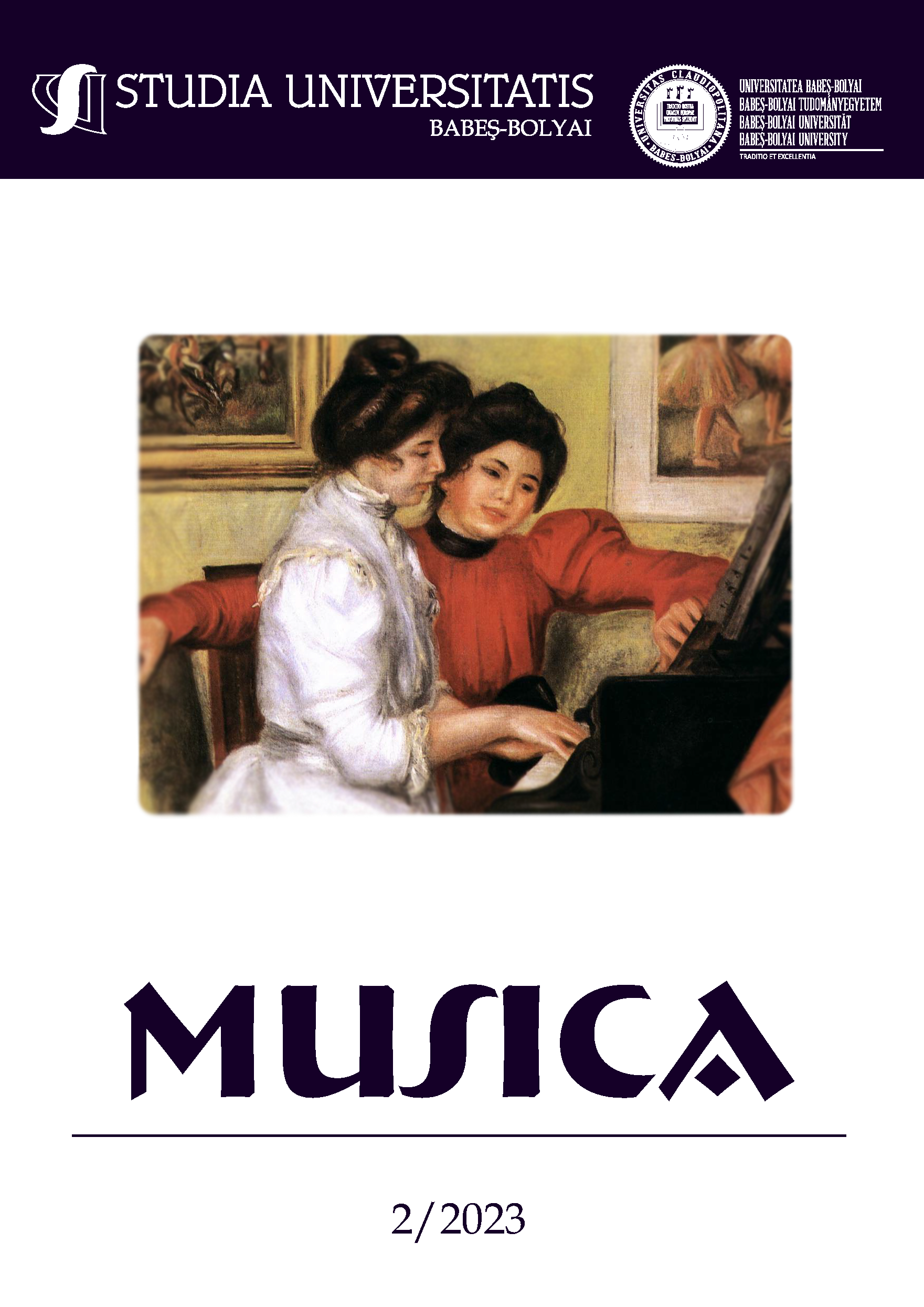"The Gates of Sky" by Ede Terényi: Sources and Context
DOI:
https://doi.org/10.24193/subbmusica.2023.2.27Keywords:
Ede Terényi, The Gates of Sky, choir music, ritual, world tree.Abstract
The ninth decade of the last century brought an opening for domestic composers towards themes less tolerated until then, especially religious ones. In the case of Ede Terényi, this resulted, among other, in a considerable number of church choral works of Protestant and Catholic origin. The Gates of Sky composed in 1996 stands out in this context not only for its musical complexity, but also for the way it deals with a subject that has its roots beyond Christianity in archaic cultures. Our study aims to investigate those factors that contributed to the conception of this piece rich in meaning and significance, its sources of inspiration, and the shaping of the text of the three movements. In a subsequent study we will also discuss elements of style and expression in a detailed musical analysis.
References
Bernáth Béla. A szerelem titkos nyelvén (In the secret language of love). Gondolat Kiadó, Budapest, 1986.
Coca Gabriela. Ha folyóvĺz volnék ... (Had I been running water ...), equal voices choir, op. 1, by Ede Terényi (1954). In Studia UBB Musica, LVII, 1, 2012, p. 259-265.
Diószegi Vilmos. A pogány magyarok hitvilága (The Beliefs of the Pagan Hungarians). Akadémiai Kiadó, Budapest, 1978.
Diószegi Vilmos. Samanizmus (Shamanism), second edition. Terebess Kiadó, Budapest, 1998.
Dombi Józsefné [ed.]. Évfordulós zeneszerzők, 2009: tanulmánykötet (Anniversary composers, 2009: book of studies). SZTE JPGY Művészeti Intézet Ének-Zene Tanszék, Szeged, 2010.
Erdélyi Zsuzsanna. Hegyet hágék, lőtőt lépék (Climbing the mountain, down to the valley), second edition. Magvető Könykiadó, Budapest, 1976.
Földes Imre. Harmincasok. Beszélgetés magyar zeneszerzőkkel (The Thirties. Conversations with Hungarian composers). Zeneműkiadó Vállalat, Budapest, 1969.
Gerle János [ed.] Országépítő, Kaposvár, 1993/4.
Hausmann Kóródy Alice [ed.]. Erdélyiség a magyar zeneszerzők műveiben (Transylvanianism in the Works of Hungarian Composers). Partium Kiadó, Nagyvárad, 2018.
Hausmann Kóródy Alice [ed.]. Ami ihlet… éltet – In memoriam Terényi Ede (What inspires... is life-giving - In memoriam Ede Terényi). Partium Kiadó, Nagyvárad, 2021.
Hoppál-Jankovics-Nagy-Szemadám [eds.]. Jelképtár (Dictionary of Symbols), second, revised edition. Helikon Kiadó, Budapest, 1994.
Jankovics Marcell. A fa mitológiája (The Mythology of the Tree). Csokonai Kiadóvállalat, Debrecen, 1991.
Kőszeghy Attila [ed.]. Országépítő (Country Builder), 2012/3.
Makkái János [ed.]. Népújság, Vol. XLVIII, No. 126, 1996. június 28.
Ortutay Gyula [ed.]. Magyar Néprajzi Lexikon (Hungarian Ethnographic Encyclopedia), Volume I. Akadémiai Kiadó, Budapest, 1977.
Ortutay Gyula [ed.]. Magyar Néprajzi Lexikon (Hungarian Ethnographic Lexicon), Volume IV. Akadémiai Kiadó, Budapest, 1981.
Ortutay Gyula [ed.]. Magyar Néprajzi Lexikon (Hungarian Ethnographic Encyclopedia), Volume V. Akadémiai Kiadó, Budapest, 1982.
Papp Endre [ed.]. Hitel, 30/5 (2017. május).
Pál József - Újvári Edit [eds.]. Szimbólumtár. Jelképek, motívumok, témák az egyetemes és a magyar kultúrából (Dictionary of Symbols. Symbols, Motifs, Themes from the Universal and Hungarian Culture). Balassi Kiadó, Budapest, 1997.
Szőcs Géza [ed.]. Erdélyi Napló, 1996. augusztus 7., No. 32.
Takács Szilvia. A nyelvi mágia eszközei az epikus ráolvasó imádságokban (The Tools of Verbal Charms in Epic Prayers). Doctoral dissertation. Eötvös Loránd Tudományegyetem, Bölcsészettudományi Kar, Budapest, 2004.
Tánczos Vilmos. Folklórszimbólumok (Folklore Symbols). Kriza János Néprajzi Társaság, Kolozsvár, 2006Terényi Ede. Paramuzikológia (Paramusicology). Cluj-Napoca, 2001.
Tánczos Vilmos. Nyiss kaput, angyal! Moldvai csángó népi imádságok. Archetipikus szimbolizáció és élettér (Angel, open the door! Archetypal symbolism and life space). Püski Kiadó, Budapest, 2001.
Terényi Ede. A hét torony (The Seven Towered-Castle). Grafycolor, Cluj-Napoca, 2012.
Terényi Ede. Choir Book - Mixed Choirs. Grafycolor, Cluj-Napoca, 2005.
Terényi Ede. The Gates of Sky. Grafycolor, Cluj-Napoca, 2013.
Terényi Ede. The Harmony of the Modern Music. Grafycolor, Cluj, 2006.
Terényi Ede. Zene, költői világ (Music, Poetic World). Grafycolor, Cluj-Napoca, 2008.
Terényi Ede. Zeném – Életem. Gondolatok – arcképek – emlékek. Életrajz I. (My Music - My Life. Thoughts – portraits – memories. Autobiography I.). Grafycolor, Cluj-Napoca, 2020.
Terényi Ede. Zene tegnap, ma, holnap (Music yesterday, today and tomorrow). Stúdium Könyvkiadó, Kolozsvár, 2004.
Downloads
Published
How to Cite
Issue
Section
License
Copyright (c) 2023 Studia Universitatis Babeș-Bolyai Musica

This work is licensed under a Creative Commons Attribution-NonCommercial-NoDerivatives 4.0 International License.



